International Business Case Study: Analyzing Samsung's Competitiveness
VerifiedAdded on 2022/08/12
|10
|2947
|17
Case Study
AI Summary
This case study examines Samsung's competitive strategies, market leadership, and innovation within the context of international business. The analysis explores Samsung's rise as a global leader in the electronics sector, highlighting key elements such as effective market leadership, new product development, and a robust supply chain. The study also considers the influence of South Korea's business climate, including the role of chaebols and government support, on Samsung's operations. Furthermore, the case delves into Samsung's innovation strategy, emphasizing its impact on the company's success, including its ability to overtake competitors like Apple. The study also touches upon challenges such as the importance of adapting to market changes and maintaining profitability. The assignment also covers the main elements of competitive strategy, business climate of the region of South Korea, and innovative strategies followed by Samsung to gain a competitive advantage.
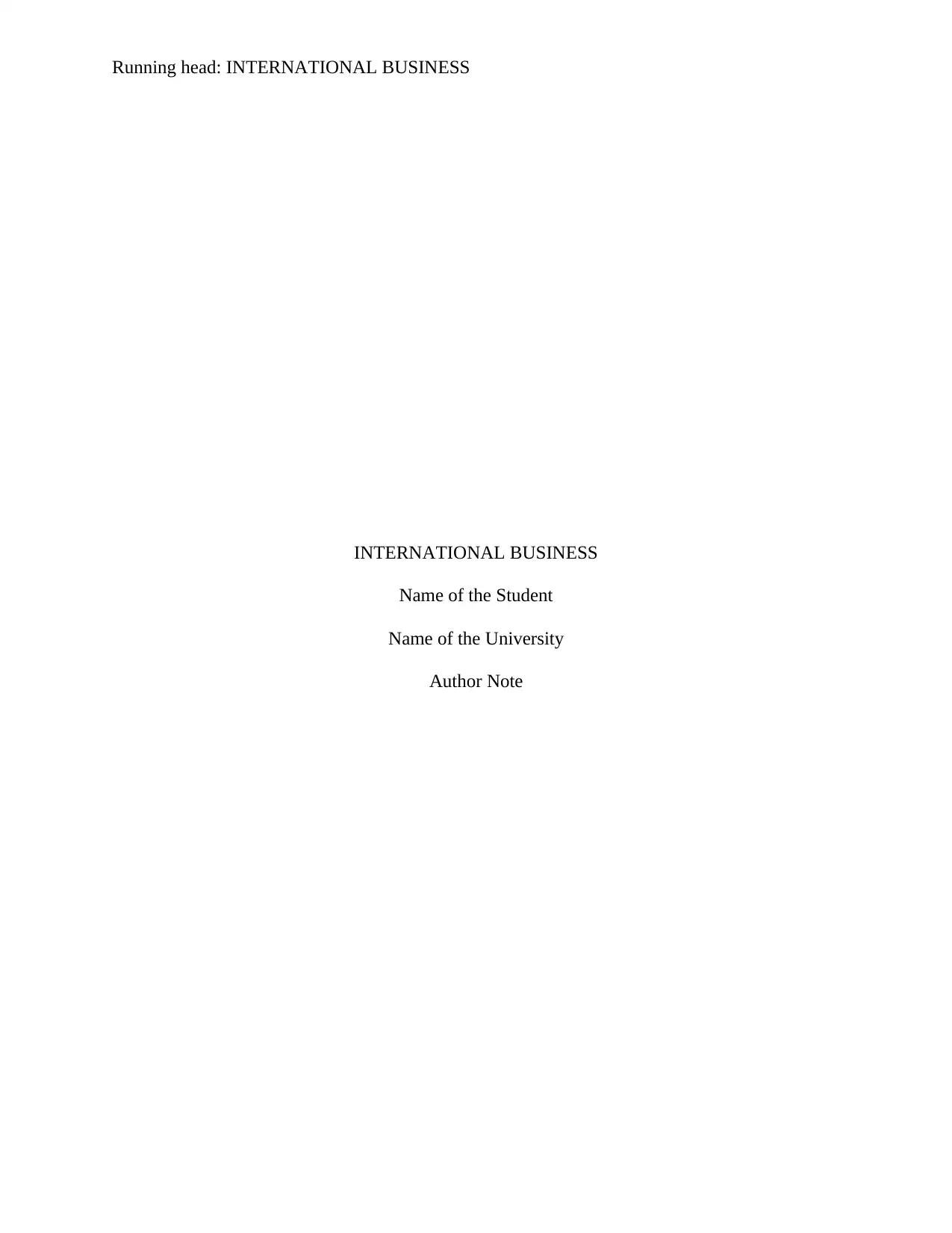
Running head: INTERNATIONAL BUSINESS
INTERNATIONAL BUSINESS
Name of the Student
Name of the University
Author Note
INTERNATIONAL BUSINESS
Name of the Student
Name of the University
Author Note
Paraphrase This Document
Need a fresh take? Get an instant paraphrase of this document with our AI Paraphraser
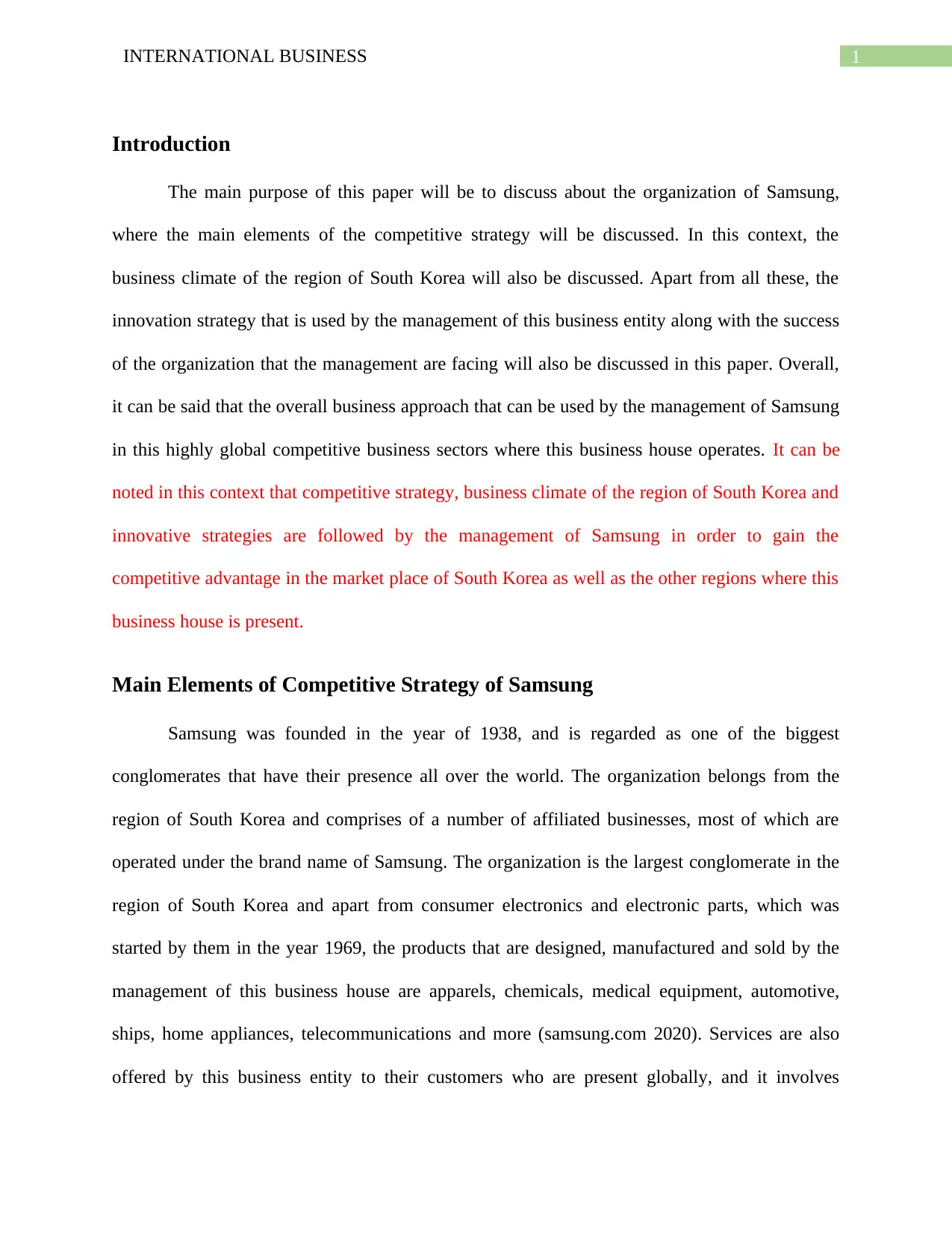
1INTERNATIONAL BUSINESS
Introduction
The main purpose of this paper will be to discuss about the organization of Samsung,
where the main elements of the competitive strategy will be discussed. In this context, the
business climate of the region of South Korea will also be discussed. Apart from all these, the
innovation strategy that is used by the management of this business entity along with the success
of the organization that the management are facing will also be discussed in this paper. Overall,
it can be said that the overall business approach that can be used by the management of Samsung
in this highly global competitive business sectors where this business house operates. It can be
noted in this context that competitive strategy, business climate of the region of South Korea and
innovative strategies are followed by the management of Samsung in order to gain the
competitive advantage in the market place of South Korea as well as the other regions where this
business house is present.
Main Elements of Competitive Strategy of Samsung
Samsung was founded in the year of 1938, and is regarded as one of the biggest
conglomerates that have their presence all over the world. The organization belongs from the
region of South Korea and comprises of a number of affiliated businesses, most of which are
operated under the brand name of Samsung. The organization is the largest conglomerate in the
region of South Korea and apart from consumer electronics and electronic parts, which was
started by them in the year 1969, the products that are designed, manufactured and sold by the
management of this business house are apparels, chemicals, medical equipment, automotive,
ships, home appliances, telecommunications and more (samsung.com 2020). Services are also
offered by this business entity to their customers who are present globally, and it involves
Introduction
The main purpose of this paper will be to discuss about the organization of Samsung,
where the main elements of the competitive strategy will be discussed. In this context, the
business climate of the region of South Korea will also be discussed. Apart from all these, the
innovation strategy that is used by the management of this business entity along with the success
of the organization that the management are facing will also be discussed in this paper. Overall,
it can be said that the overall business approach that can be used by the management of Samsung
in this highly global competitive business sectors where this business house operates. It can be
noted in this context that competitive strategy, business climate of the region of South Korea and
innovative strategies are followed by the management of Samsung in order to gain the
competitive advantage in the market place of South Korea as well as the other regions where this
business house is present.
Main Elements of Competitive Strategy of Samsung
Samsung was founded in the year of 1938, and is regarded as one of the biggest
conglomerates that have their presence all over the world. The organization belongs from the
region of South Korea and comprises of a number of affiliated businesses, most of which are
operated under the brand name of Samsung. The organization is the largest conglomerate in the
region of South Korea and apart from consumer electronics and electronic parts, which was
started by them in the year 1969, the products that are designed, manufactured and sold by the
management of this business house are apparels, chemicals, medical equipment, automotive,
ships, home appliances, telecommunications and more (samsung.com 2020). Services are also
offered by this business entity to their customers who are present globally, and it involves
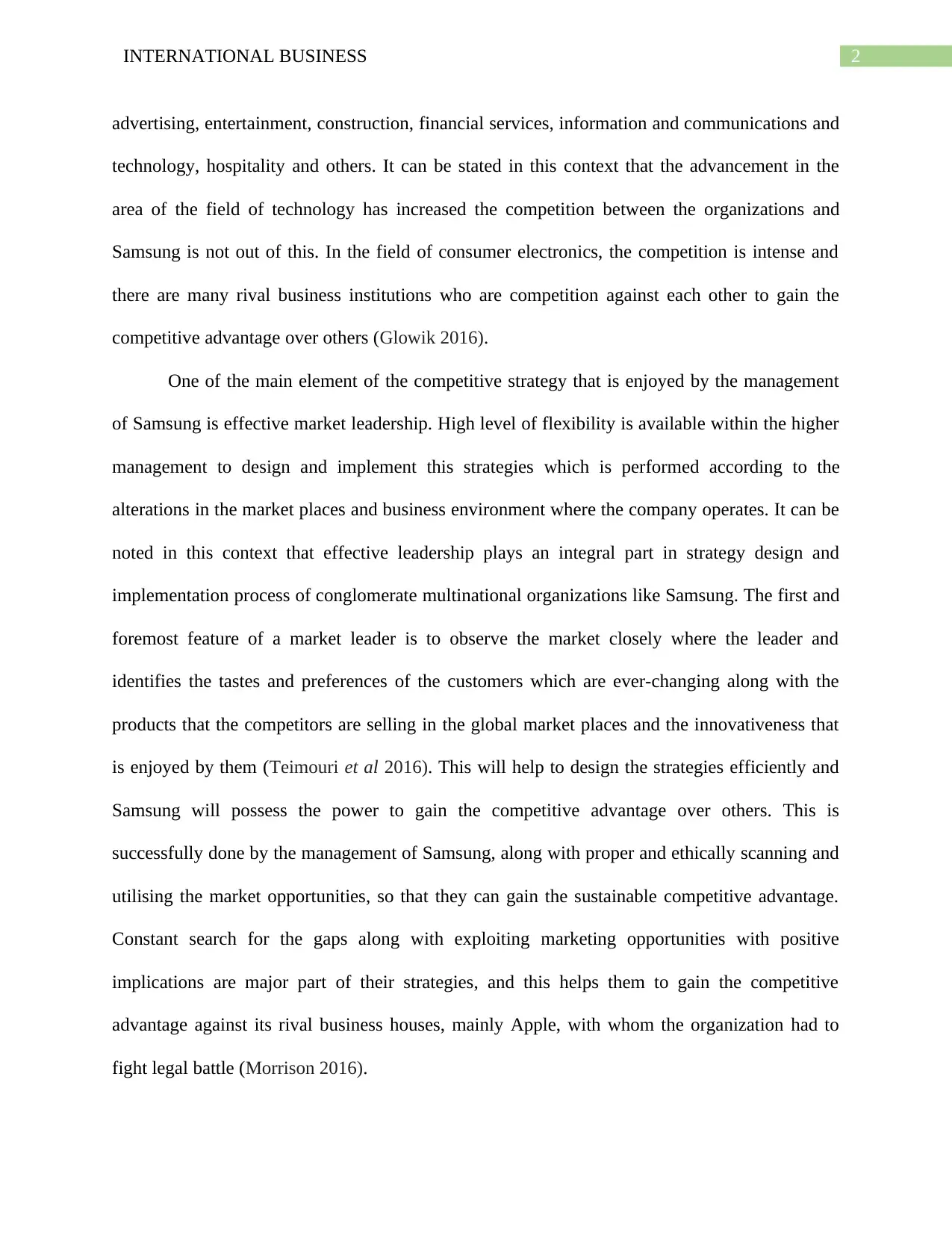
2INTERNATIONAL BUSINESS
advertising, entertainment, construction, financial services, information and communications and
technology, hospitality and others. It can be stated in this context that the advancement in the
area of the field of technology has increased the competition between the organizations and
Samsung is not out of this. In the field of consumer electronics, the competition is intense and
there are many rival business institutions who are competition against each other to gain the
competitive advantage over others (Glowik 2016).
One of the main element of the competitive strategy that is enjoyed by the management
of Samsung is effective market leadership. High level of flexibility is available within the higher
management to design and implement this strategies which is performed according to the
alterations in the market places and business environment where the company operates. It can be
noted in this context that effective leadership plays an integral part in strategy design and
implementation process of conglomerate multinational organizations like Samsung. The first and
foremost feature of a market leader is to observe the market closely where the leader and
identifies the tastes and preferences of the customers which are ever-changing along with the
products that the competitors are selling in the global market places and the innovativeness that
is enjoyed by them (Teimouri et al 2016). This will help to design the strategies efficiently and
Samsung will possess the power to gain the competitive advantage over others. This is
successfully done by the management of Samsung, along with proper and ethically scanning and
utilising the market opportunities, so that they can gain the sustainable competitive advantage.
Constant search for the gaps along with exploiting marketing opportunities with positive
implications are major part of their strategies, and this helps them to gain the competitive
advantage against its rival business houses, mainly Apple, with whom the organization had to
fight legal battle (Morrison 2016).
advertising, entertainment, construction, financial services, information and communications and
technology, hospitality and others. It can be stated in this context that the advancement in the
area of the field of technology has increased the competition between the organizations and
Samsung is not out of this. In the field of consumer electronics, the competition is intense and
there are many rival business institutions who are competition against each other to gain the
competitive advantage over others (Glowik 2016).
One of the main element of the competitive strategy that is enjoyed by the management
of Samsung is effective market leadership. High level of flexibility is available within the higher
management to design and implement this strategies which is performed according to the
alterations in the market places and business environment where the company operates. It can be
noted in this context that effective leadership plays an integral part in strategy design and
implementation process of conglomerate multinational organizations like Samsung. The first and
foremost feature of a market leader is to observe the market closely where the leader and
identifies the tastes and preferences of the customers which are ever-changing along with the
products that the competitors are selling in the global market places and the innovativeness that
is enjoyed by them (Teimouri et al 2016). This will help to design the strategies efficiently and
Samsung will possess the power to gain the competitive advantage over others. This is
successfully done by the management of Samsung, along with proper and ethically scanning and
utilising the market opportunities, so that they can gain the sustainable competitive advantage.
Constant search for the gaps along with exploiting marketing opportunities with positive
implications are major part of their strategies, and this helps them to gain the competitive
advantage against its rival business houses, mainly Apple, with whom the organization had to
fight legal battle (Morrison 2016).
⊘ This is a preview!⊘
Do you want full access?
Subscribe today to unlock all pages.

Trusted by 1+ million students worldwide
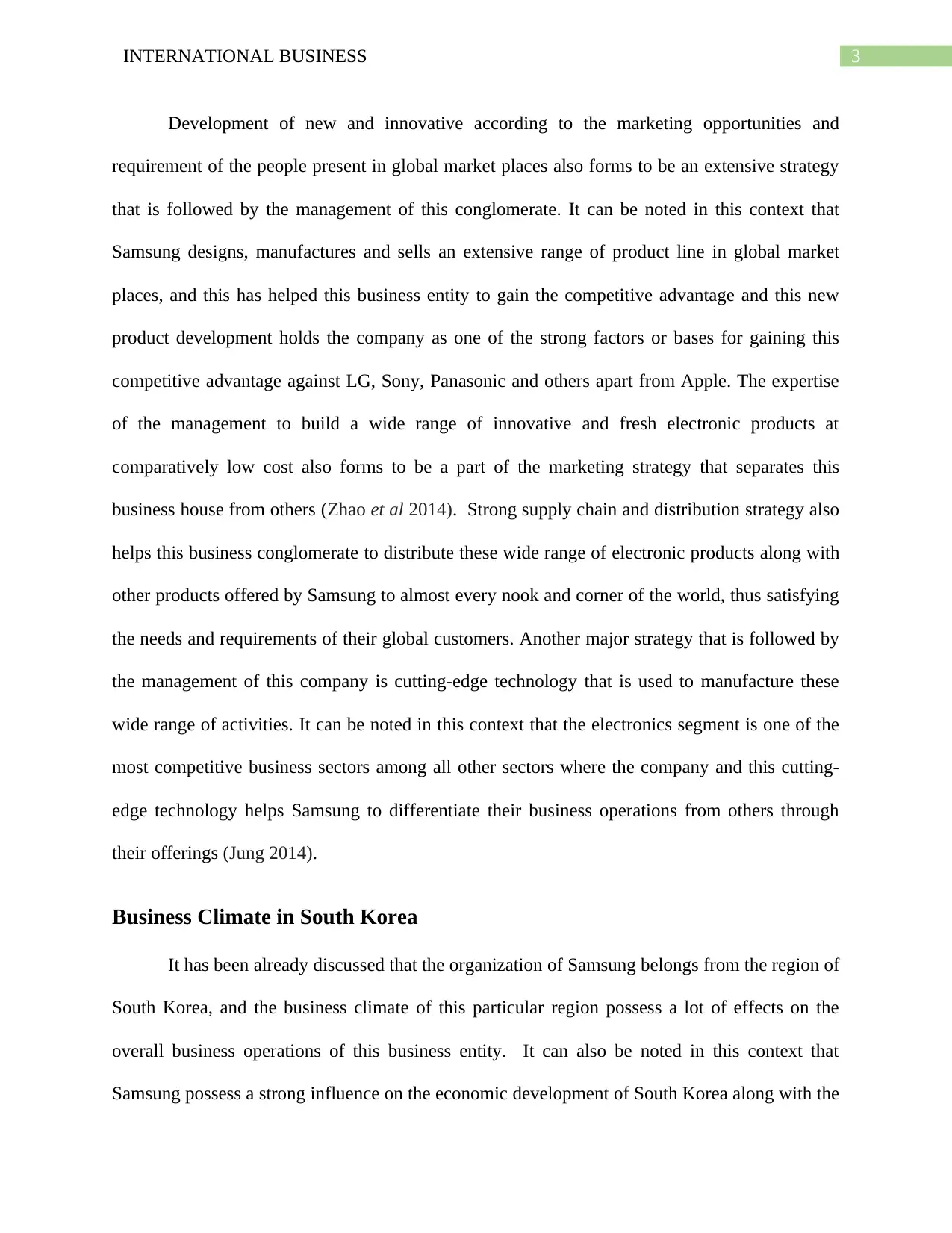
3INTERNATIONAL BUSINESS
Development of new and innovative according to the marketing opportunities and
requirement of the people present in global market places also forms to be an extensive strategy
that is followed by the management of this conglomerate. It can be noted in this context that
Samsung designs, manufactures and sells an extensive range of product line in global market
places, and this has helped this business entity to gain the competitive advantage and this new
product development holds the company as one of the strong factors or bases for gaining this
competitive advantage against LG, Sony, Panasonic and others apart from Apple. The expertise
of the management to build a wide range of innovative and fresh electronic products at
comparatively low cost also forms to be a part of the marketing strategy that separates this
business house from others (Zhao et al 2014). Strong supply chain and distribution strategy also
helps this business conglomerate to distribute these wide range of electronic products along with
other products offered by Samsung to almost every nook and corner of the world, thus satisfying
the needs and requirements of their global customers. Another major strategy that is followed by
the management of this company is cutting-edge technology that is used to manufacture these
wide range of activities. It can be noted in this context that the electronics segment is one of the
most competitive business sectors among all other sectors where the company and this cutting-
edge technology helps Samsung to differentiate their business operations from others through
their offerings (Jung 2014).
Business Climate in South Korea
It has been already discussed that the organization of Samsung belongs from the region of
South Korea, and the business climate of this particular region possess a lot of effects on the
overall business operations of this business entity. It can also be noted in this context that
Samsung possess a strong influence on the economic development of South Korea along with the
Development of new and innovative according to the marketing opportunities and
requirement of the people present in global market places also forms to be an extensive strategy
that is followed by the management of this conglomerate. It can be noted in this context that
Samsung designs, manufactures and sells an extensive range of product line in global market
places, and this has helped this business entity to gain the competitive advantage and this new
product development holds the company as one of the strong factors or bases for gaining this
competitive advantage against LG, Sony, Panasonic and others apart from Apple. The expertise
of the management to build a wide range of innovative and fresh electronic products at
comparatively low cost also forms to be a part of the marketing strategy that separates this
business house from others (Zhao et al 2014). Strong supply chain and distribution strategy also
helps this business conglomerate to distribute these wide range of electronic products along with
other products offered by Samsung to almost every nook and corner of the world, thus satisfying
the needs and requirements of their global customers. Another major strategy that is followed by
the management of this company is cutting-edge technology that is used to manufacture these
wide range of activities. It can be noted in this context that the electronics segment is one of the
most competitive business sectors among all other sectors where the company and this cutting-
edge technology helps Samsung to differentiate their business operations from others through
their offerings (Jung 2014).
Business Climate in South Korea
It has been already discussed that the organization of Samsung belongs from the region of
South Korea, and the business climate of this particular region possess a lot of effects on the
overall business operations of this business entity. It can also be noted in this context that
Samsung possess a strong influence on the economic development of South Korea along with the
Paraphrase This Document
Need a fresh take? Get an instant paraphrase of this document with our AI Paraphraser
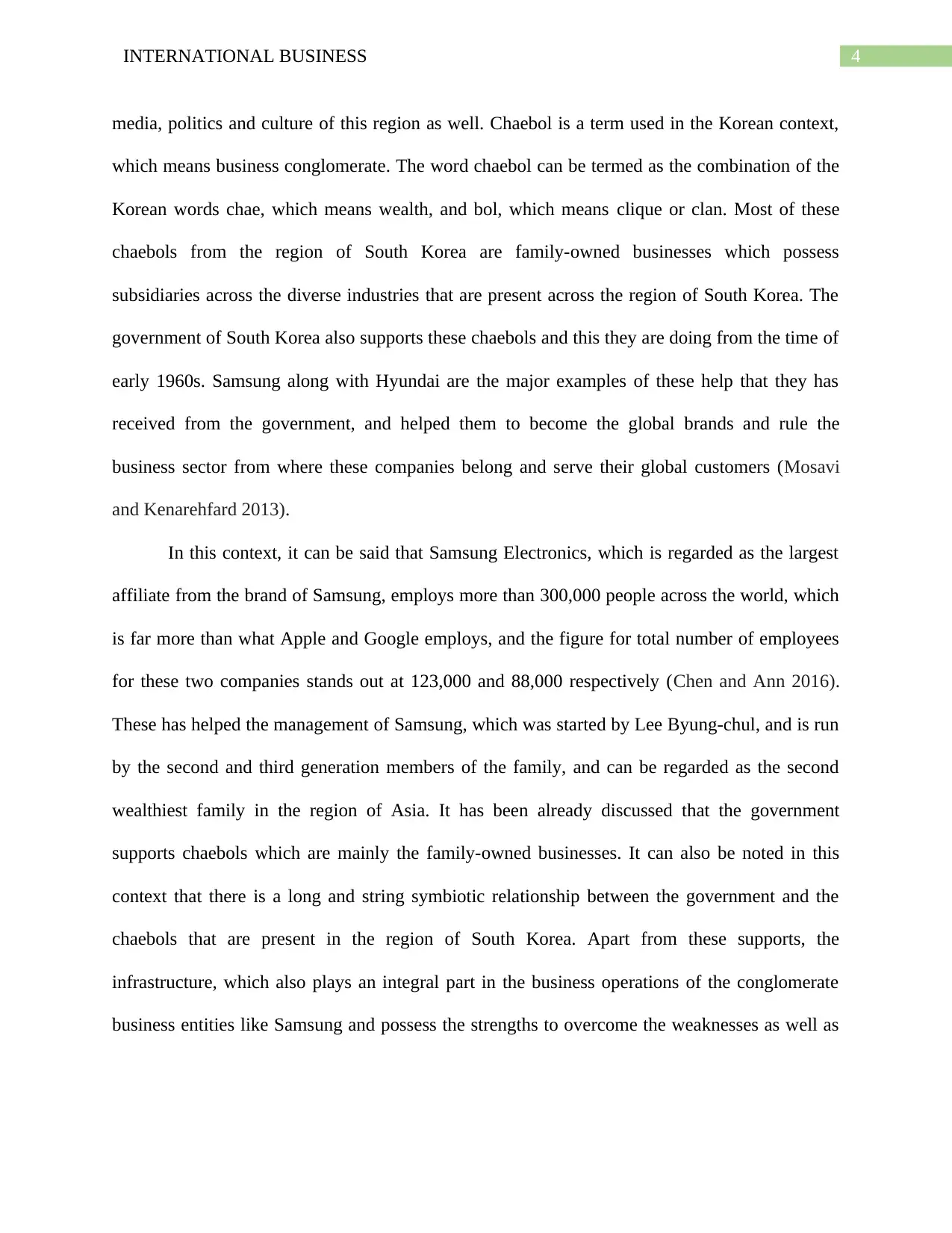
4INTERNATIONAL BUSINESS
media, politics and culture of this region as well. Chaebol is a term used in the Korean context,
which means business conglomerate. The word chaebol can be termed as the combination of the
Korean words chae, which means wealth, and bol, which means clique or clan. Most of these
chaebols from the region of South Korea are family-owned businesses which possess
subsidiaries across the diverse industries that are present across the region of South Korea. The
government of South Korea also supports these chaebols and this they are doing from the time of
early 1960s. Samsung along with Hyundai are the major examples of these help that they has
received from the government, and helped them to become the global brands and rule the
business sector from where these companies belong and serve their global customers (Mosavi
and Kenarehfard 2013).
In this context, it can be said that Samsung Electronics, which is regarded as the largest
affiliate from the brand of Samsung, employs more than 300,000 people across the world, which
is far more than what Apple and Google employs, and the figure for total number of employees
for these two companies stands out at 123,000 and 88,000 respectively (Chen and Ann 2016).
These has helped the management of Samsung, which was started by Lee Byung-chul, and is run
by the second and third generation members of the family, and can be regarded as the second
wealthiest family in the region of Asia. It has been already discussed that the government
supports chaebols which are mainly the family-owned businesses. It can also be noted in this
context that there is a long and string symbiotic relationship between the government and the
chaebols that are present in the region of South Korea. Apart from these supports, the
infrastructure, which also plays an integral part in the business operations of the conglomerate
business entities like Samsung and possess the strengths to overcome the weaknesses as well as
media, politics and culture of this region as well. Chaebol is a term used in the Korean context,
which means business conglomerate. The word chaebol can be termed as the combination of the
Korean words chae, which means wealth, and bol, which means clique or clan. Most of these
chaebols from the region of South Korea are family-owned businesses which possess
subsidiaries across the diverse industries that are present across the region of South Korea. The
government of South Korea also supports these chaebols and this they are doing from the time of
early 1960s. Samsung along with Hyundai are the major examples of these help that they has
received from the government, and helped them to become the global brands and rule the
business sector from where these companies belong and serve their global customers (Mosavi
and Kenarehfard 2013).
In this context, it can be said that Samsung Electronics, which is regarded as the largest
affiliate from the brand of Samsung, employs more than 300,000 people across the world, which
is far more than what Apple and Google employs, and the figure for total number of employees
for these two companies stands out at 123,000 and 88,000 respectively (Chen and Ann 2016).
These has helped the management of Samsung, which was started by Lee Byung-chul, and is run
by the second and third generation members of the family, and can be regarded as the second
wealthiest family in the region of Asia. It has been already discussed that the government
supports chaebols which are mainly the family-owned businesses. It can also be noted in this
context that there is a long and string symbiotic relationship between the government and the
chaebols that are present in the region of South Korea. Apart from these supports, the
infrastructure, which also plays an integral part in the business operations of the conglomerate
business entities like Samsung and possess the strengths to overcome the weaknesses as well as
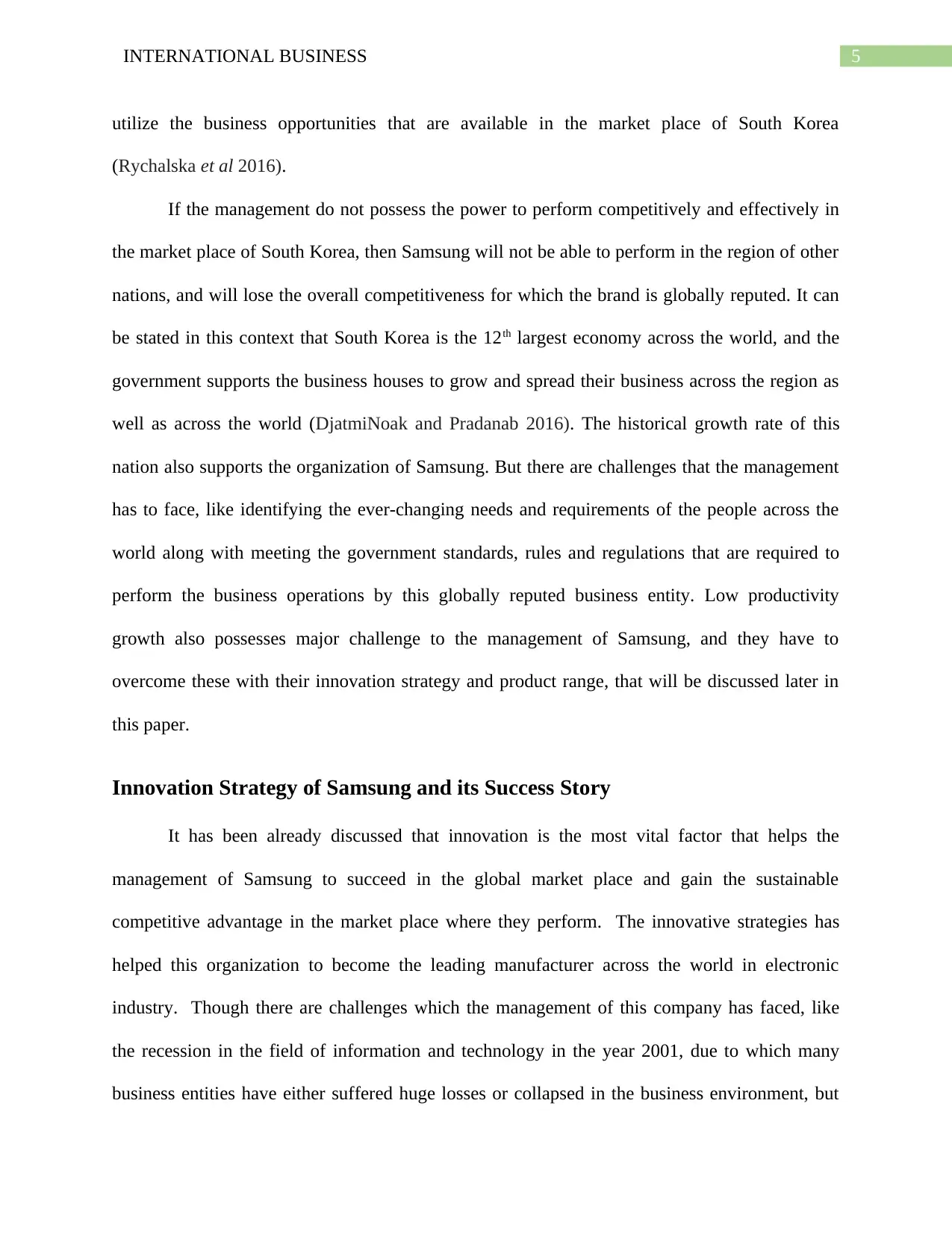
5INTERNATIONAL BUSINESS
utilize the business opportunities that are available in the market place of South Korea
(Rychalska et al 2016).
If the management do not possess the power to perform competitively and effectively in
the market place of South Korea, then Samsung will not be able to perform in the region of other
nations, and will lose the overall competitiveness for which the brand is globally reputed. It can
be stated in this context that South Korea is the 12th largest economy across the world, and the
government supports the business houses to grow and spread their business across the region as
well as across the world (DjatmiNoak and Pradanab 2016). The historical growth rate of this
nation also supports the organization of Samsung. But there are challenges that the management
has to face, like identifying the ever-changing needs and requirements of the people across the
world along with meeting the government standards, rules and regulations that are required to
perform the business operations by this globally reputed business entity. Low productivity
growth also possesses major challenge to the management of Samsung, and they have to
overcome these with their innovation strategy and product range, that will be discussed later in
this paper.
Innovation Strategy of Samsung and its Success Story
It has been already discussed that innovation is the most vital factor that helps the
management of Samsung to succeed in the global market place and gain the sustainable
competitive advantage in the market place where they perform. The innovative strategies has
helped this organization to become the leading manufacturer across the world in electronic
industry. Though there are challenges which the management of this company has faced, like
the recession in the field of information and technology in the year 2001, due to which many
business entities have either suffered huge losses or collapsed in the business environment, but
utilize the business opportunities that are available in the market place of South Korea
(Rychalska et al 2016).
If the management do not possess the power to perform competitively and effectively in
the market place of South Korea, then Samsung will not be able to perform in the region of other
nations, and will lose the overall competitiveness for which the brand is globally reputed. It can
be stated in this context that South Korea is the 12th largest economy across the world, and the
government supports the business houses to grow and spread their business across the region as
well as across the world (DjatmiNoak and Pradanab 2016). The historical growth rate of this
nation also supports the organization of Samsung. But there are challenges that the management
has to face, like identifying the ever-changing needs and requirements of the people across the
world along with meeting the government standards, rules and regulations that are required to
perform the business operations by this globally reputed business entity. Low productivity
growth also possesses major challenge to the management of Samsung, and they have to
overcome these with their innovation strategy and product range, that will be discussed later in
this paper.
Innovation Strategy of Samsung and its Success Story
It has been already discussed that innovation is the most vital factor that helps the
management of Samsung to succeed in the global market place and gain the sustainable
competitive advantage in the market place where they perform. The innovative strategies has
helped this organization to become the leading manufacturer across the world in electronic
industry. Though there are challenges which the management of this company has faced, like
the recession in the field of information and technology in the year 2001, due to which many
business entities have either suffered huge losses or collapsed in the business environment, but
⊘ This is a preview!⊘
Do you want full access?
Subscribe today to unlock all pages.

Trusted by 1+ million students worldwide
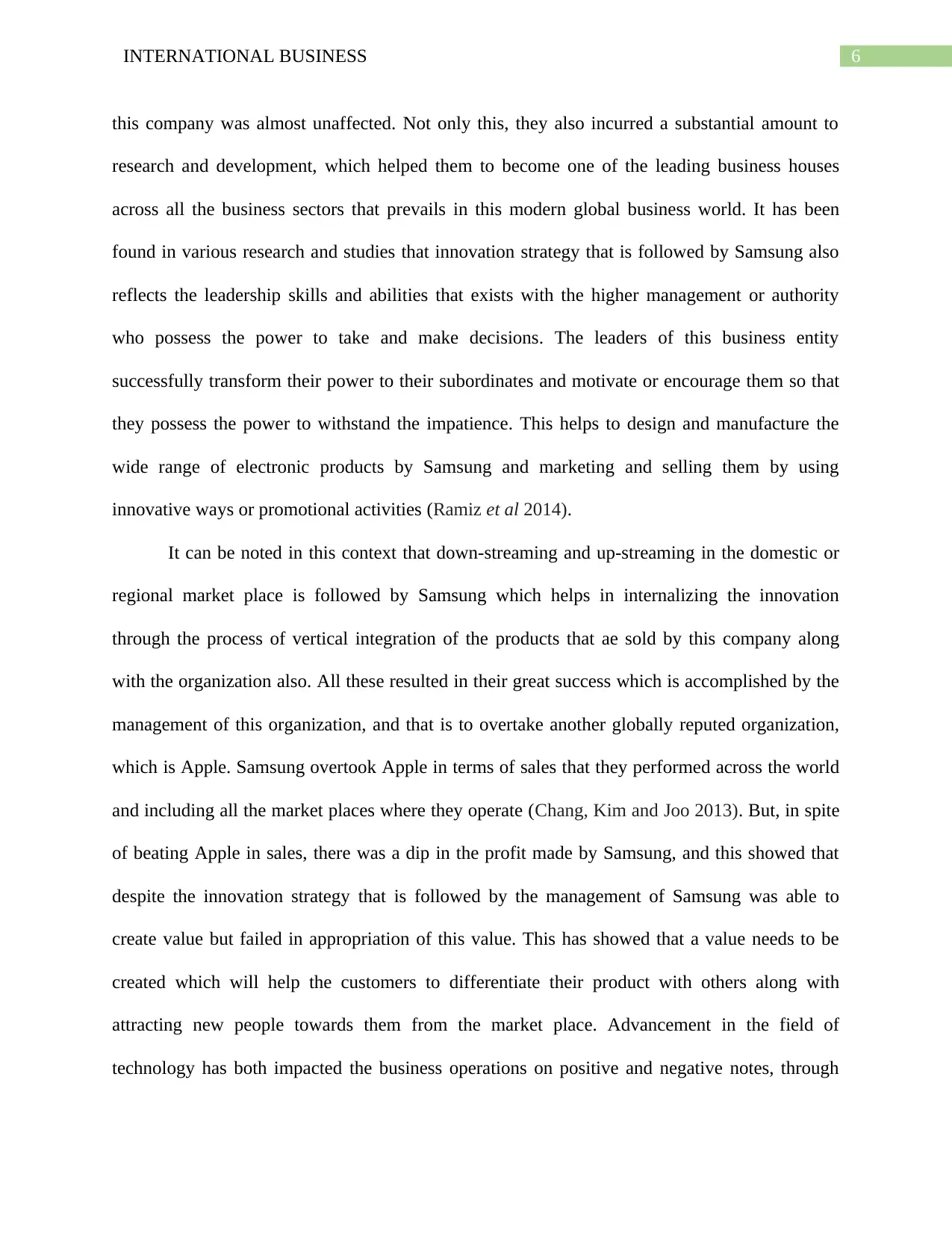
6INTERNATIONAL BUSINESS
this company was almost unaffected. Not only this, they also incurred a substantial amount to
research and development, which helped them to become one of the leading business houses
across all the business sectors that prevails in this modern global business world. It has been
found in various research and studies that innovation strategy that is followed by Samsung also
reflects the leadership skills and abilities that exists with the higher management or authority
who possess the power to take and make decisions. The leaders of this business entity
successfully transform their power to their subordinates and motivate or encourage them so that
they possess the power to withstand the impatience. This helps to design and manufacture the
wide range of electronic products by Samsung and marketing and selling them by using
innovative ways or promotional activities (Ramiz et al 2014).
It can be noted in this context that down-streaming and up-streaming in the domestic or
regional market place is followed by Samsung which helps in internalizing the innovation
through the process of vertical integration of the products that ae sold by this company along
with the organization also. All these resulted in their great success which is accomplished by the
management of this organization, and that is to overtake another globally reputed organization,
which is Apple. Samsung overtook Apple in terms of sales that they performed across the world
and including all the market places where they operate (Chang, Kim and Joo 2013). But, in spite
of beating Apple in sales, there was a dip in the profit made by Samsung, and this showed that
despite the innovation strategy that is followed by the management of Samsung was able to
create value but failed in appropriation of this value. This has showed that a value needs to be
created which will help the customers to differentiate their product with others along with
attracting new people towards them from the market place. Advancement in the field of
technology has both impacted the business operations on positive and negative notes, through
this company was almost unaffected. Not only this, they also incurred a substantial amount to
research and development, which helped them to become one of the leading business houses
across all the business sectors that prevails in this modern global business world. It has been
found in various research and studies that innovation strategy that is followed by Samsung also
reflects the leadership skills and abilities that exists with the higher management or authority
who possess the power to take and make decisions. The leaders of this business entity
successfully transform their power to their subordinates and motivate or encourage them so that
they possess the power to withstand the impatience. This helps to design and manufacture the
wide range of electronic products by Samsung and marketing and selling them by using
innovative ways or promotional activities (Ramiz et al 2014).
It can be noted in this context that down-streaming and up-streaming in the domestic or
regional market place is followed by Samsung which helps in internalizing the innovation
through the process of vertical integration of the products that ae sold by this company along
with the organization also. All these resulted in their great success which is accomplished by the
management of this organization, and that is to overtake another globally reputed organization,
which is Apple. Samsung overtook Apple in terms of sales that they performed across the world
and including all the market places where they operate (Chang, Kim and Joo 2013). But, in spite
of beating Apple in sales, there was a dip in the profit made by Samsung, and this showed that
despite the innovation strategy that is followed by the management of Samsung was able to
create value but failed in appropriation of this value. This has showed that a value needs to be
created which will help the customers to differentiate their product with others along with
attracting new people towards them from the market place. Advancement in the field of
technology has both impacted the business operations on positive and negative notes, through
Paraphrase This Document
Need a fresh take? Get an instant paraphrase of this document with our AI Paraphraser
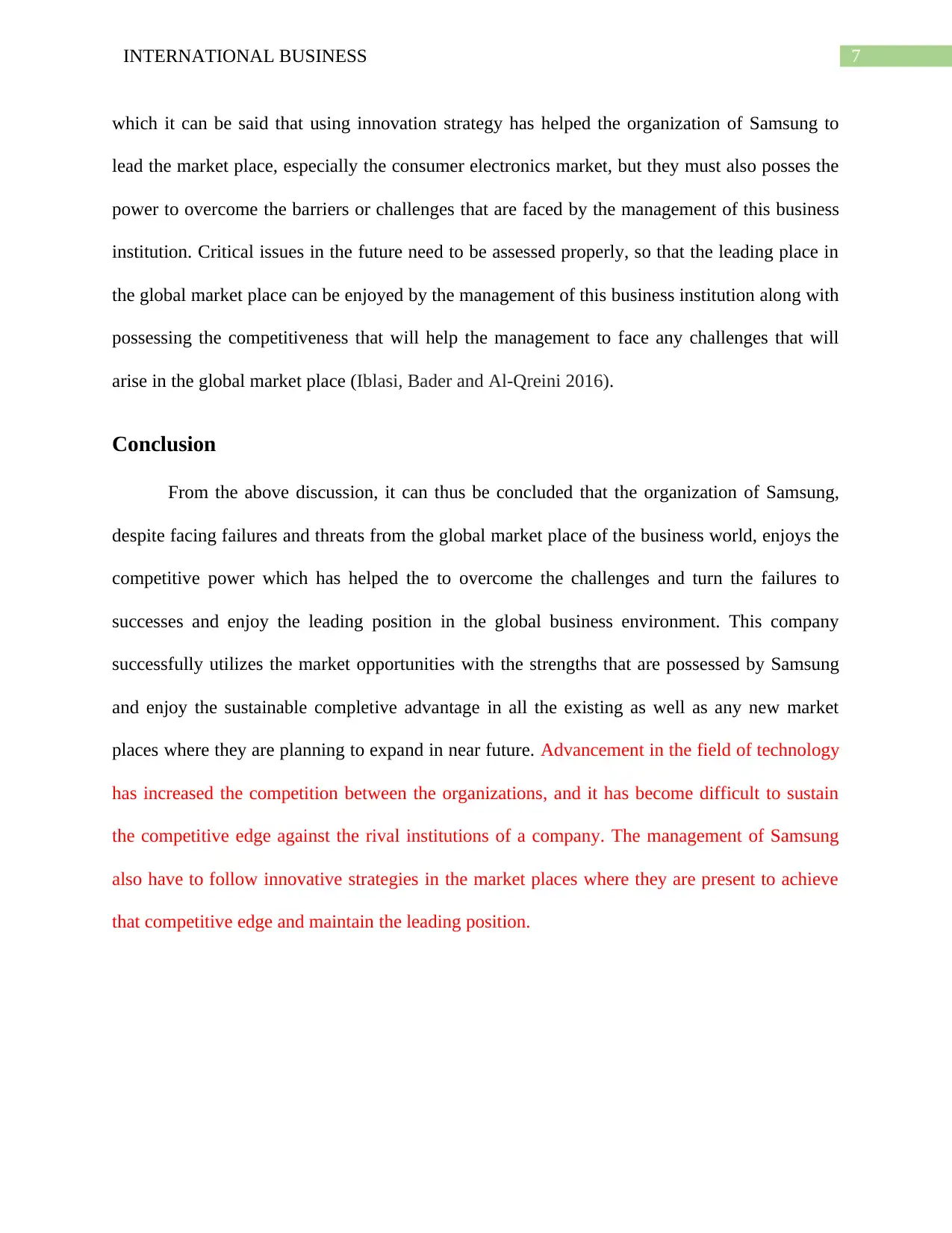
7INTERNATIONAL BUSINESS
which it can be said that using innovation strategy has helped the organization of Samsung to
lead the market place, especially the consumer electronics market, but they must also posses the
power to overcome the barriers or challenges that are faced by the management of this business
institution. Critical issues in the future need to be assessed properly, so that the leading place in
the global market place can be enjoyed by the management of this business institution along with
possessing the competitiveness that will help the management to face any challenges that will
arise in the global market place (Iblasi, Bader and Al-Qreini 2016).
Conclusion
From the above discussion, it can thus be concluded that the organization of Samsung,
despite facing failures and threats from the global market place of the business world, enjoys the
competitive power which has helped the to overcome the challenges and turn the failures to
successes and enjoy the leading position in the global business environment. This company
successfully utilizes the market opportunities with the strengths that are possessed by Samsung
and enjoy the sustainable completive advantage in all the existing as well as any new market
places where they are planning to expand in near future. Advancement in the field of technology
has increased the competition between the organizations, and it has become difficult to sustain
the competitive edge against the rival institutions of a company. The management of Samsung
also have to follow innovative strategies in the market places where they are present to achieve
that competitive edge and maintain the leading position.
which it can be said that using innovation strategy has helped the organization of Samsung to
lead the market place, especially the consumer electronics market, but they must also posses the
power to overcome the barriers or challenges that are faced by the management of this business
institution. Critical issues in the future need to be assessed properly, so that the leading place in
the global market place can be enjoyed by the management of this business institution along with
possessing the competitiveness that will help the management to face any challenges that will
arise in the global market place (Iblasi, Bader and Al-Qreini 2016).
Conclusion
From the above discussion, it can thus be concluded that the organization of Samsung,
despite facing failures and threats from the global market place of the business world, enjoys the
competitive power which has helped the to overcome the challenges and turn the failures to
successes and enjoy the leading position in the global business environment. This company
successfully utilizes the market opportunities with the strengths that are possessed by Samsung
and enjoy the sustainable completive advantage in all the existing as well as any new market
places where they are planning to expand in near future. Advancement in the field of technology
has increased the competition between the organizations, and it has become difficult to sustain
the competitive edge against the rival institutions of a company. The management of Samsung
also have to follow innovative strategies in the market places where they are present to achieve
that competitive edge and maintain the leading position.
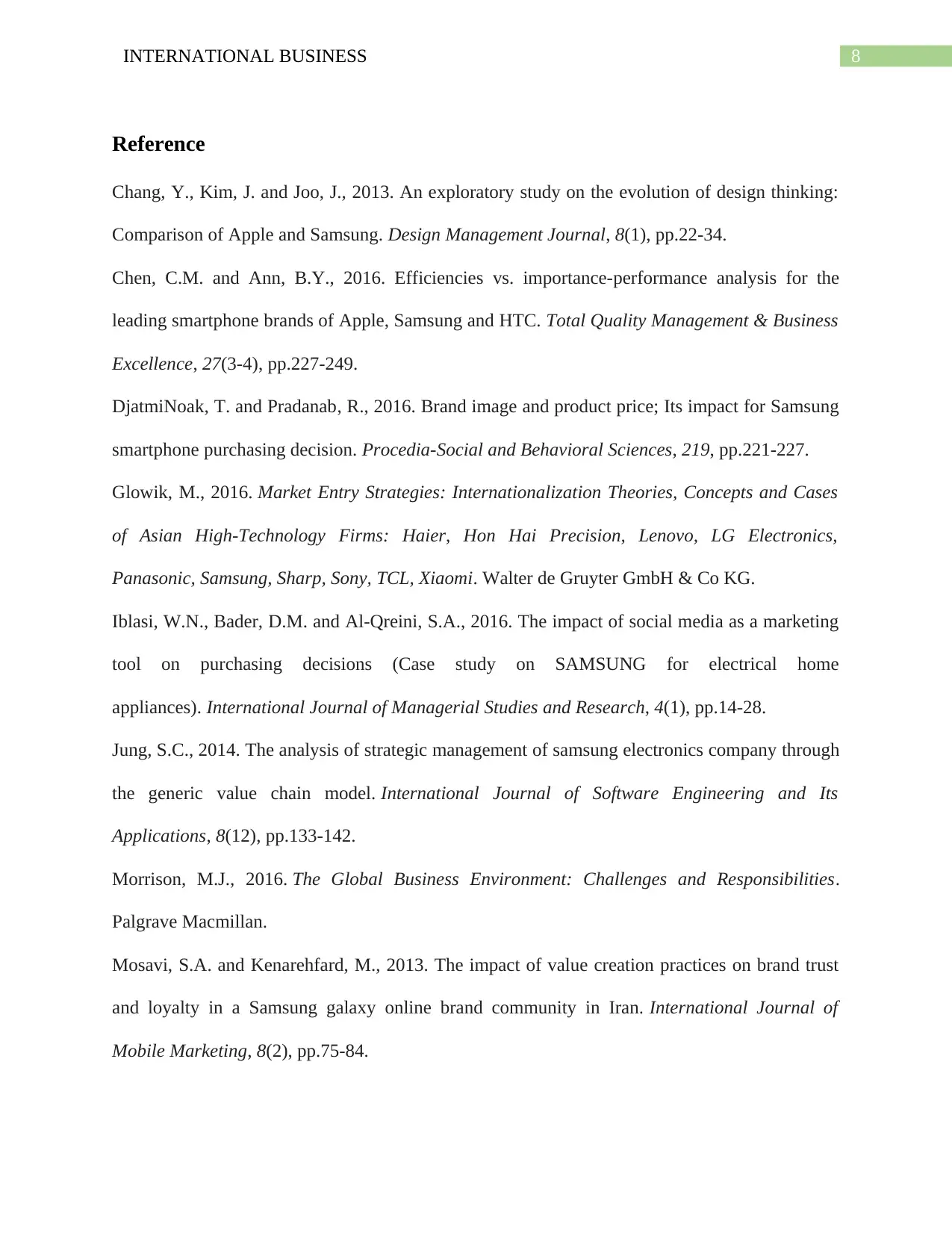
8INTERNATIONAL BUSINESS
Reference
Chang, Y., Kim, J. and Joo, J., 2013. An exploratory study on the evolution of design thinking:
Comparison of Apple and Samsung. Design Management Journal, 8(1), pp.22-34.
Chen, C.M. and Ann, B.Y., 2016. Efficiencies vs. importance-performance analysis for the
leading smartphone brands of Apple, Samsung and HTC. Total Quality Management & Business
Excellence, 27(3-4), pp.227-249.
DjatmiNoak, T. and Pradanab, R., 2016. Brand image and product price; Its impact for Samsung
smartphone purchasing decision. Procedia-Social and Behavioral Sciences, 219, pp.221-227.
Glowik, M., 2016. Market Entry Strategies: Internationalization Theories, Concepts and Cases
of Asian High-Technology Firms: Haier, Hon Hai Precision, Lenovo, LG Electronics,
Panasonic, Samsung, Sharp, Sony, TCL, Xiaomi. Walter de Gruyter GmbH & Co KG.
Iblasi, W.N., Bader, D.M. and Al-Qreini, S.A., 2016. The impact of social media as a marketing
tool on purchasing decisions (Case study on SAMSUNG for electrical home
appliances). International Journal of Managerial Studies and Research, 4(1), pp.14-28.
Jung, S.C., 2014. The analysis of strategic management of samsung electronics company through
the generic value chain model. International Journal of Software Engineering and Its
Applications, 8(12), pp.133-142.
Morrison, M.J., 2016. The Global Business Environment: Challenges and Responsibilities.
Palgrave Macmillan.
Mosavi, S.A. and Kenarehfard, M., 2013. The impact of value creation practices on brand trust
and loyalty in a Samsung galaxy online brand community in Iran. International Journal of
Mobile Marketing, 8(2), pp.75-84.
Reference
Chang, Y., Kim, J. and Joo, J., 2013. An exploratory study on the evolution of design thinking:
Comparison of Apple and Samsung. Design Management Journal, 8(1), pp.22-34.
Chen, C.M. and Ann, B.Y., 2016. Efficiencies vs. importance-performance analysis for the
leading smartphone brands of Apple, Samsung and HTC. Total Quality Management & Business
Excellence, 27(3-4), pp.227-249.
DjatmiNoak, T. and Pradanab, R., 2016. Brand image and product price; Its impact for Samsung
smartphone purchasing decision. Procedia-Social and Behavioral Sciences, 219, pp.221-227.
Glowik, M., 2016. Market Entry Strategies: Internationalization Theories, Concepts and Cases
of Asian High-Technology Firms: Haier, Hon Hai Precision, Lenovo, LG Electronics,
Panasonic, Samsung, Sharp, Sony, TCL, Xiaomi. Walter de Gruyter GmbH & Co KG.
Iblasi, W.N., Bader, D.M. and Al-Qreini, S.A., 2016. The impact of social media as a marketing
tool on purchasing decisions (Case study on SAMSUNG for electrical home
appliances). International Journal of Managerial Studies and Research, 4(1), pp.14-28.
Jung, S.C., 2014. The analysis of strategic management of samsung electronics company through
the generic value chain model. International Journal of Software Engineering and Its
Applications, 8(12), pp.133-142.
Morrison, M.J., 2016. The Global Business Environment: Challenges and Responsibilities.
Palgrave Macmillan.
Mosavi, S.A. and Kenarehfard, M., 2013. The impact of value creation practices on brand trust
and loyalty in a Samsung galaxy online brand community in Iran. International Journal of
Mobile Marketing, 8(2), pp.75-84.
⊘ This is a preview!⊘
Do you want full access?
Subscribe today to unlock all pages.

Trusted by 1+ million students worldwide
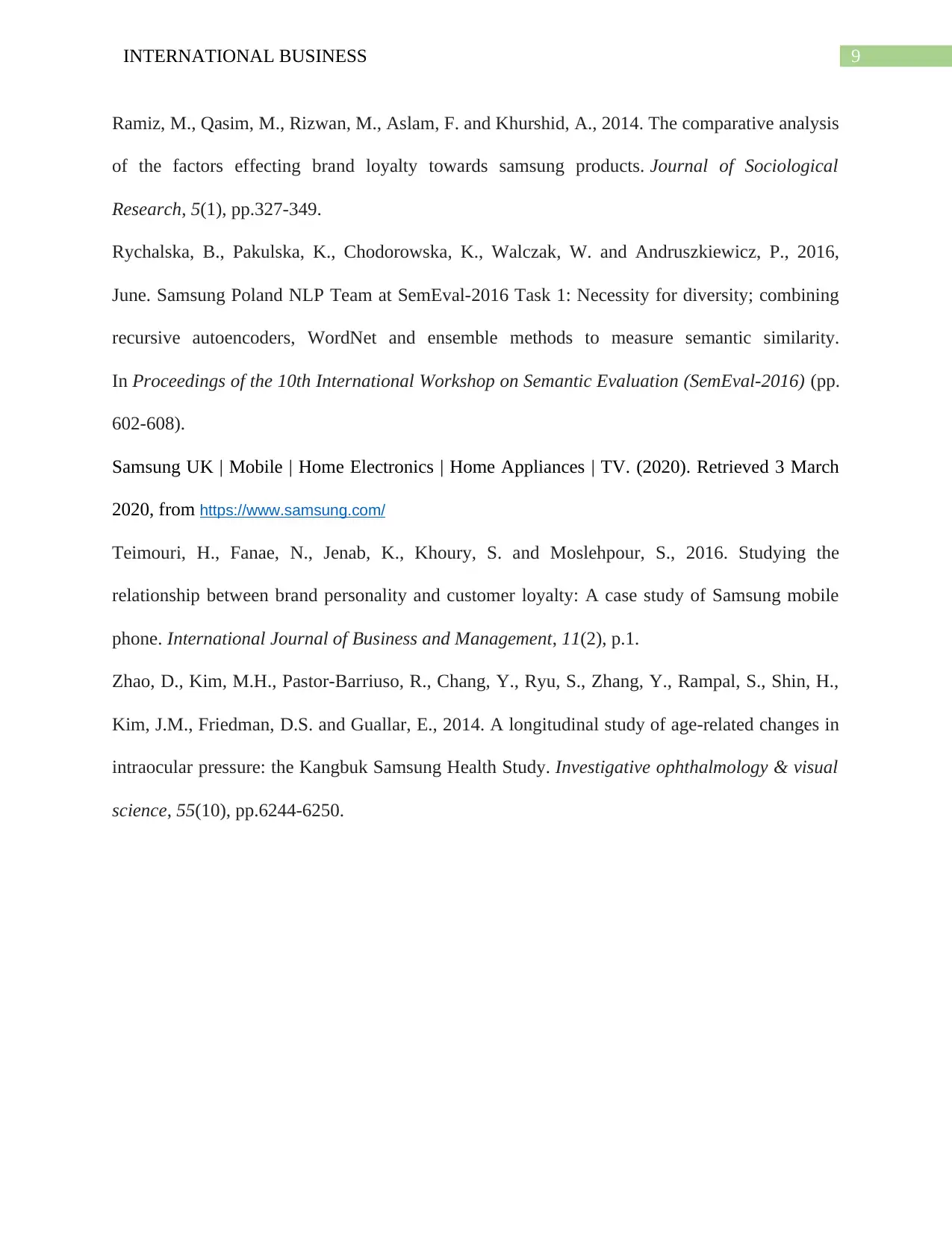
9INTERNATIONAL BUSINESS
Ramiz, M., Qasim, M., Rizwan, M., Aslam, F. and Khurshid, A., 2014. The comparative analysis
of the factors effecting brand loyalty towards samsung products. Journal of Sociological
Research, 5(1), pp.327-349.
Rychalska, B., Pakulska, K., Chodorowska, K., Walczak, W. and Andruszkiewicz, P., 2016,
June. Samsung Poland NLP Team at SemEval-2016 Task 1: Necessity for diversity; combining
recursive autoencoders, WordNet and ensemble methods to measure semantic similarity.
In Proceedings of the 10th International Workshop on Semantic Evaluation (SemEval-2016) (pp.
602-608).
Samsung UK | Mobile | Home Electronics | Home Appliances | TV. (2020). Retrieved 3 March
2020, from https://www.samsung.com/
Teimouri, H., Fanae, N., Jenab, K., Khoury, S. and Moslehpour, S., 2016. Studying the
relationship between brand personality and customer loyalty: A case study of Samsung mobile
phone. International Journal of Business and Management, 11(2), p.1.
Zhao, D., Kim, M.H., Pastor-Barriuso, R., Chang, Y., Ryu, S., Zhang, Y., Rampal, S., Shin, H.,
Kim, J.M., Friedman, D.S. and Guallar, E., 2014. A longitudinal study of age-related changes in
intraocular pressure: the Kangbuk Samsung Health Study. Investigative ophthalmology & visual
science, 55(10), pp.6244-6250.
Ramiz, M., Qasim, M., Rizwan, M., Aslam, F. and Khurshid, A., 2014. The comparative analysis
of the factors effecting brand loyalty towards samsung products. Journal of Sociological
Research, 5(1), pp.327-349.
Rychalska, B., Pakulska, K., Chodorowska, K., Walczak, W. and Andruszkiewicz, P., 2016,
June. Samsung Poland NLP Team at SemEval-2016 Task 1: Necessity for diversity; combining
recursive autoencoders, WordNet and ensemble methods to measure semantic similarity.
In Proceedings of the 10th International Workshop on Semantic Evaluation (SemEval-2016) (pp.
602-608).
Samsung UK | Mobile | Home Electronics | Home Appliances | TV. (2020). Retrieved 3 March
2020, from https://www.samsung.com/
Teimouri, H., Fanae, N., Jenab, K., Khoury, S. and Moslehpour, S., 2016. Studying the
relationship between brand personality and customer loyalty: A case study of Samsung mobile
phone. International Journal of Business and Management, 11(2), p.1.
Zhao, D., Kim, M.H., Pastor-Barriuso, R., Chang, Y., Ryu, S., Zhang, Y., Rampal, S., Shin, H.,
Kim, J.M., Friedman, D.S. and Guallar, E., 2014. A longitudinal study of age-related changes in
intraocular pressure: the Kangbuk Samsung Health Study. Investigative ophthalmology & visual
science, 55(10), pp.6244-6250.
1 out of 10
Related Documents
Your All-in-One AI-Powered Toolkit for Academic Success.
+13062052269
info@desklib.com
Available 24*7 on WhatsApp / Email
![[object Object]](/_next/static/media/star-bottom.7253800d.svg)
Unlock your academic potential
Copyright © 2020–2025 A2Z Services. All Rights Reserved. Developed and managed by ZUCOL.





